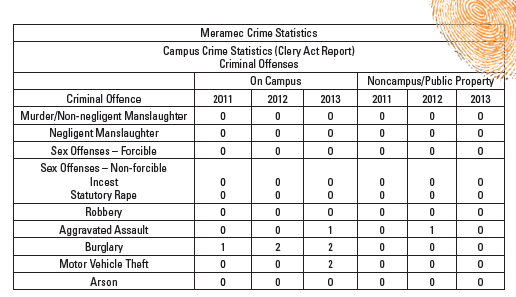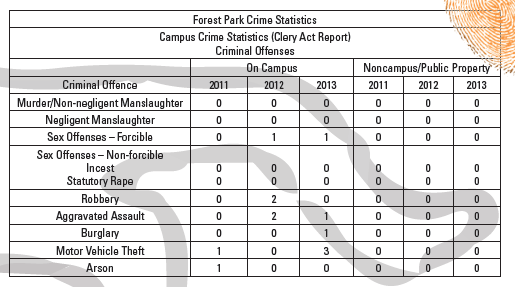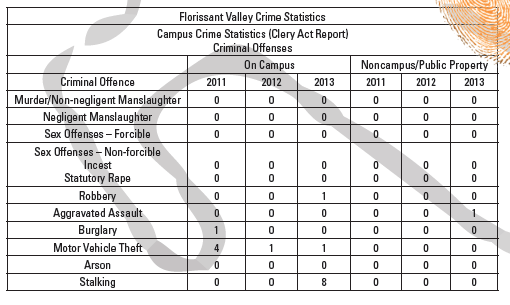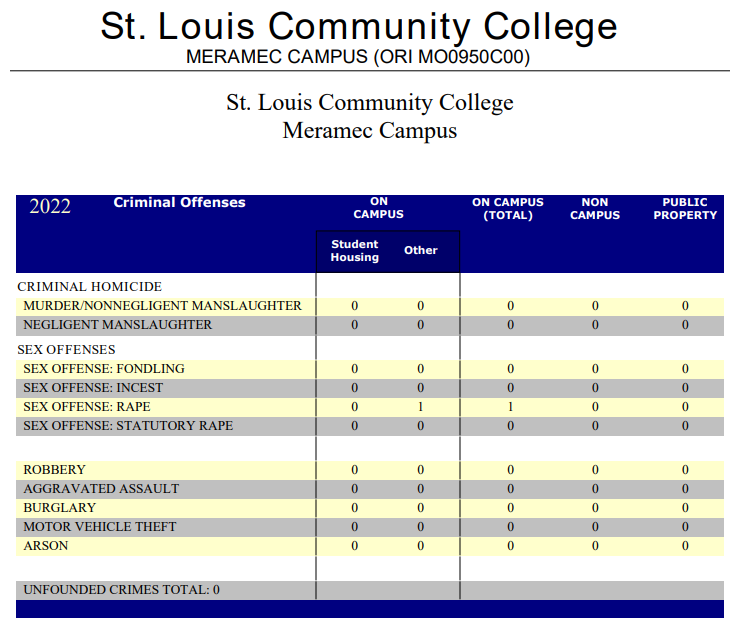The nuts and bolts of campus crime reporting
By: SPENCER GLEASON
Editor in Chief
BY: LIVIE HALL
Managing Editor
Illustrations by Marissa Diercks
What is the Clery Report?
The United States Department of Education requires most college campuses to submit an annual report of the crime statistics on and around their campus. This report is known as the Clery Report. Formally known as the Jeanne Clery Disclosure of Campus Security Policy and Campus Crime Statistics Act, the act originated when Connie and Howard Clery lost their daughter, Jeanne, when she was raped and murdered in her college dorm room. Her parents worked to create a better system for campus crimes to be reported when they learned of how little statistical information was available to students and their parents.
In the Clery Act requires colleges to have the annual Clery Report, a public crime log and disclose crime statistics for on and around campus. Crimes that have to be reported are homicide, sex offenses, robbery, aggravated assault, burglary, motor vehicle theft and arson. They must also include any liquor, drug or weapon violations.
Meramec Campus Police Chief Anthony Russo works with other STLCC campus police chiefs to put together an annual report and show campus crime statistics. Vice President of Student Affairs Kim Fitzgerald works with Russo on the Behavioral Intervention Team (BIT.) The BIT handles any Title IX incidents such as domestic violence and stalking. Every BIT report is filed as a police report and some of those reports will fall under Clery. Assistant Vice Chancellor William Woodward works with each STLCC campus to ensure they are in compliance with the law and do each Clery Report correctly.
All Clery Act information is from clerycenter.org.
What goes in the Clery Report
Meramec Campus Police Chief Anthony Russo said the police chiefs from each St. Louis Community College campus meet to discuss what goes into the Clery Report. They look over each other’s reports and statistics from the year to consolidate everything.
The Clery report can work with the Behavioral Intervention Team (BIT) reports. Everything reported to BIT is also put into a police report. Russo said if someone commits a “major part one crime,” it is filed as a police report, a BIT report and the BIT is pulled into the case. A crime like this would be homicide, burglary, forcible sexual offenses, arson, auto theft and aggravated assault. These acts would go into the Clery Report. Major thefts are not required to go on the report.
Russo said he and his officers recently made an arrest on someone for stealing a $700 phone. The case went through the BIT and legal processes. They also broke a check cashing ring that was around for almost three years. Two people were writing bad checks at every STLCC bookstore. These are major thefts that are made into a police report.
What is Title IX and the Violence Against Women Act?
According to the National Center for Education Statistics, Title IX “protects people from discrimination based on sex in education programs and activities that receive federal financial assistance.” According to the American Bar Association, the Violence Against Women Act is “a federal law aimed at ending violence against women and remedying the laws and social practices that have fostered and justified the history of violence against women.”
How STLCC stays in compliance for the Clery Report
Associate Vice Chancellor of Student Affairs William Woodward started at STLCC at the end of September. His job is to make sure each STLCC campus is in compliance with the law. For the Clery Report, he makes sure things are reported and dealt with correctly and is already helping put the report together for the next year.
Among the incidents required to go in the Clery Report, Woodward said he deals with Title IX incidents, such as sexual misconduct.
Woodward is still easing into the position and looking into what things should be changed as far as guidelines go. On Oct. 20, the federal government came out with a final rule on the Violence Against Women Act (VAWA) and that has given colleges new requirements on what they are supposed to report and how they are supposed to handle education and awareness of the act. In the Spring of 2015 semester, Woodward said he hopes to bring awareness of the VAWA to the college.
“Let’s have St. Louis Community College be in the foreground of educating our citizens on campus to take it with them wherever they go after, and I can’t do that without the help of the students, faculty and staff that are here,” Woodward said.
The government requires colleges to be in compliance with the new guidelines by July 1, 2015. However the next Clery Report is not due until Oct. 1, 2015. In that report, STLCC will show the government what they have been doing to get in compliance.
How the BIT works with the Clery
As a member of the Behavioral Intervention Team (BIT) at the STLCC-Meramec campus, Vice President of Student Affairs Kim Fitzgerald sees BIT reports about students that faculty and staff have filled out. The BIT is a way to keep track of different behaviors that students display.
“The act of having a BIT team is a choice. Every college campus would have to deal with behavior,” Fitzgerald said. “BIT teams are good because it allows four people from four different perspectives to look at a report and have a conversation about what’s going on. It’s not like everything is conduct. It’s not like everything is a police act.”
The BIT consists of Fitzgerald, Meramec Police Chief Anthony Russo, Manager of Access Linden Nissenbaum and Hope Steiner, a counselor.
“The four of us don’t necessarily address what’s going on,” Fitzgerald said. “We make sure that it gets addressed.”
BIT teams were created after the Virginia Tech shooting in April 2007. Fitzgerald said that the reasoning was that everyone knew a little bit about the shooter, Seung-Hui Cho, but all of the information was not put in one place. Many things — from English class writings, individual drawings and behavior — collectively painted a picture of him, but no one knew the full picture.
“That’s why we have BIT reports, to report behavior,” Fitzgerald said. “Behavior can be unusual or it can be serious.”
The National Behavioral Intervention Team Association (NBITA) hosts conferences throughout the country. They educate educational institutions on how to deal with behavior and different levels of threats.
Information that goes beyond a BIT report and moves into criminal activity then requires a police report. However, not all BIT reports are police reports. These crimes are reported as required by the Clery Act, said Fitzgerald.
“I feel like we’re in a pretty good place right now, in terms of making sure we’ve got information that can be shared and addressed,” Fitzgerald said. “Clearly, the reason for it in the first place is [parents] wanted this information available. If I’m a parent and I’m not looking, that’s my decision. But it should be something that you should provide, so I can make the choice.”














